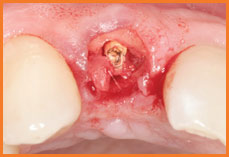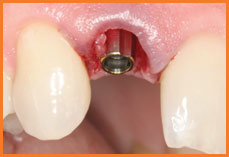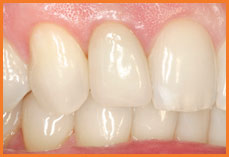Poor oral function and inferior self-esteem are just a couple of the many difficulties associated with tooth loss. Complete or partial dentures, often the solution to the problem of tooth loss, may not restore oral function completely because of poor fit due to jaw bone deterioration. Bridges, often the solution to single tooth loss, have their drawbacks too, because placing a bridge requires the teeth surrounding the missing tooth to be ground down and compromised.
To improve the aesthetics and function of tooth replacement, dental implants were developed and have gained popularity in recent years. Dental implants are titanium “screws” which are placed in the jawbone replacing the root of the lost tooth. Dental implants provide an alternative to standard removable complete and partial dentures and bridges while improving chewing function almost completely.
The Problem
In order to be a candidate for the dental implant placement procedure, a patient must have sufficient bone height and width to support the titanium post or artificial tooth root. Unfortunately, if a patient has been without a tooth or teeth for a prolonged period of time, the bone that once supported the teeth becomes weakened and deteriorates, resulting in a lack of bone height to sustain a dental implant. This is especially true when tooth loss occurs in the maxillary (upper) jaw bone. Because the maxilla rests against the sinus, when bone loss occurs, the sinus expands to fill the space once occupied by jaw bone.
The Solution
To solve this issue, sinus augmentation (lift) procedures have been developed allowing bone in the upper jaw to be regenerated providing ample space to place a dental implant. The sinus lift procedure, invented in the mid 1970′s has been refined and is now frequently successfully performed. Different versions of the sinus lift procedure have evolved over time, each successful in different cases.
Successful, predictable dental implant placement in the posterior maxilla typically requires a minimum of 10mm of vertical bone height. Moreover, bone density in the posterior maxilla is often poor, which could lead to complications during implant fixation. To address these problems, maxillary sinus elevation surgery was developed to increase the amount of bone available for implant placement and has proven successful and become popular, allowing patients with insufficient bone to undergo dental implant surgery. The type of sinus augmentation that a surgeon chooses to use on a given patient depends on the surgeon’s preference as well as patient anatomy.
Types of Sinus Augmentation (Lift) Procedures:
The Lateral Window Technique (LWT)
Implant placement can be performed simultaneously with the sinus elevation procedure or following a healing period that can last 6-9 months. Immediate placement during sinus elevation reduces overall healing time and eliminates another surgical procedure, which can be desirable to patients. The decision to place an implant during sinus augmentation is dependent on the presence of adequate bone volume and quality to provide for initial stability of the implant. Rosen and colleagues (1999) recommended at least 5mm of native bone for immediate implant placement during sinus augmentation. However, more recent studies have found that implant stability can be achieved with less than 5mm (Peleg 2006).
Lateral Window Sinus Augmentation: The lateral approach involves a modified Caldwell-Luc operation to gain access to the sinus cavity. A bony window is created in the lateral maxillary wall, the Schneiderian membrane is elevated, and bone grafting material is a combination of autogenous bone and allograft. An absorbable collagen membrane is placed between the bone graft and the membrane as well as over the bony window.
This technique is usually the preferred method of sinus elevation in situations of poor bone quality and minimal residual bone height because it allows for direct visualization and accurate bone placement and volume at the position of the implant. Also, tearing of the membrane can be easily treated, minimizing contamination of the graft during healing.
The Crestal Core Elevation (CCE)
The Crestal Core or Crestal Window Elevation technique is an alternative to the traditional Lateral Window technique typically used in Sinus Elevation surgeries. While usually successful, the Lateral Window technique may cause patients to withstand post-operative pain, bruising and swelling. This limitation of the Lateral Window technique may be due to the “blind” nature of the procedure and the lack of visibility when the clinician is manipulating the Schneiderian Membrane and opening the sinus floor. To combat the associated post-op complications, the Crestal Core technique was developed.
The Crestal Core technique for sinus augmentation is reportedly less invasive than the lateral window technique. In an August 2010 study posted in the Journal of American Periodontology, 45 patients who had undergone the CCT were retrospectively evaluated over a 1-11 year period of time. The Crestal Core technique was successful in 31 of 45 sites (68.9%) and partially successful in 6 sites (13.3%). Surgical failures were reportedly due to core detachment which resulted in large tears of the sinus membrane. Implants placed in successful sites presented 100% survival rate during the duration of the study.
The conclusion was made that the Crestal Core Technique, when implemented simultaneously with molar extraction provided therapeutic benefits to the patient post-operatively. The subsequent dental implant placements using CCE showed a fantastic survival rate as well in the evaluated population.
The Crestal Window approach to sinus augmentation is simple, predictable technique which results in very low patient morbidity. It is, therefore, a suitable alternative to traditional sinus augmentation, giving clinicians a choice of techniques when approaching cases of varying degrees of difficulty and complication. The Crestal Core Technique may be the best option for elevating the sinus for many patients.
The Osteotome Technique (Summers Technique)
One of the more conservative methods of sinus elevation is the Osteotome or Summers Technique. This technique involves sinus elevation immediately followed by dental implant placement. During the osteotome technique, a tiny hole is made in the jaw bone and bone grafting material is inserted into the area between the sinus floor and the bone, increasing the distance between the sinus and the jaw. This technique allows for immediate implant placement and allows for shorter post-treatment waiting times. The Osteotome technique is considered one of the least invasive of the sinus augmentation techniques.
Balloon Sinus Elevation
The minimally invasive Zimmer Sinus Lift Balloon allows for improved vertical sinus elevation results and gives clinicians added security when performing a traditional lateral wall sinus lift procedure — protecting the Schneiderian membrane from tearing, which can significantly disrupt an implant case. The balloon instrument is also well-suited for effectively measuring the required bone grafting material. For example, 1cc of saline, which is used to inflate the balloon, is equal to 1cc of grafting material.
The Zimmer Sinus Lift Balloon is available in three convenient, single-use configurations for optimum efficiency and ease-of-use. The angled design is ideal for lateral window procedures, the straight model is well suited for a crestal approach, and the popular micro-mini design can be used for either of these indications.
Conclusion
Numerous studies have shown that dental implant survival rate is higher in patients whose dental implants were placed in grafted sinuses than the dental implants placed without sinus lifts. The sinus augmentation procedure provides a way to increase the amount and quality of available bone and allows for the placement of longer implants, leading to increased stability. Many different techniques exist for effective bone augmentation below the sinus, a few of which were discussed earlier in this report. Which approach is used is largely dependent on the extent of the patient’s bone loss and the specific procedure that is slated to be performed for the dental implant and final restoration. Given the many options available for sinus augmentation, it stands to reason that only a highly trained dental specialist can decide which procedure is the most suitable option for proper, successful treatment.
If you enjoyed this article on maxillary sinus augmentations, there is a good chance you will like these articles from my blog as well:
- “What Are Dental Implants“
- “Dental Implants Information“
- “Answers To Common Questions About Dental Implants“
- “Dental Implant Time Lapse Video“
- “Dental Implant Success Rates”
- “Metal Free Ceramic Dental Implants“
Thanks for Reading !!























































